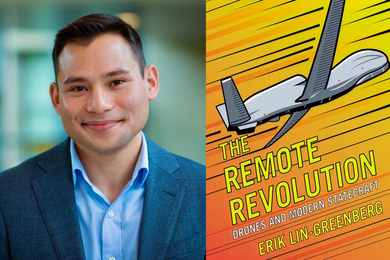A proposed expedition next month in waters off the coast of Washington state would use robotic submarines and buoys that talk to one another to gather information that could ultimately aid the cleanup of oil spills in this and similar areas. The scientists involved hope to learn more about the tidal mixing of river and ocean waters.
The experiment, planned to run from June 10 through July 5 pending approval from the National Marine Fisheries Service, involves the transmission of brief pulses of sound. As a result, the scientists have worked closely with marine biologists to ensure that there is no potential for injury to marine mammals.
The researchers are from MIT, the Woods Hole Oceanographic Institution (WHOI), the Institute of Ocean Sciences (IOS), and the University of Victoria (UVIC), British Columbia. Professor Henrik Schmidt, associate head of the Department of Ocean Engineering (OE), leads the MIT and WHOI program; David Farmer leads the IOS team in Canada.
THE EXPERIMENT
Surface slicks of foam, seaweed or other detritus in coastal waters often signify a tidal front, in which two different water masses-for example, river and ocean water-meet. Characterized by vigorous mixing, the front stirs nutrient-rich water up into the surface layer, attracting a variety of plants and animals. Fronts are therefore important to the food chain.
But while scientists understand that the mixing along a front supports an abundance of life, there are uncertainties about the way in which the water mixes in the first place. They hope to solve this puzzle by studying a tidal front at Haro Strait, a narrow channel between Washington State and Vancouver Island, BC. To do so, they will bring together for the first time autonomous underwater vehicles (AUVs), buoys that talk to one another, and instruments designed to image acoustically the small-scale structure of the front.
Understanding the mixing at the front may help protect Haro Strait and similar environments. The experimental site itself is a very busy waterway adjoining the straits of Juan de Fuca and Rosario, along which numerous tankers carry Alaskan oil. If a tanker ruptures anywhere in this area, emergency crews would have to act wisely to save marine life. They can only do so if they understand how waters in the strait move and mix the spill.
The five buoys, tethered to the ocean floor, will be clustered around the rough location of the front. Acoustic instrumentation along the length of each tether will send and receive short pulses of sound. This sound can be used to detect the front and to communicate with the AUVs (which also send and receive sound).
Sound travels at different speeds through waters of different temperature and salinity. So by tracking the speed of sound from one tether to another, the scientists hope to map extreme changes in salinity and temperature. This would indicate the rough location of the front.
However, this technique cannot give details about the front. Enter the AUVs. Once the front is found (its position changes based on the tides), its location will be communicated to the AUVs. The robots will then move in to take detailed measurements of salinity and temperature and otherwise characterize the area.
Imaging sonars will be fitted both to the AUVs and a freely drifting buoy. "The sonars will acquire images of turbulence effects on the surface and beneath, providing valuable insight on the way in which mixing takes place," Dr. Farmer said. A ship will make detailed maps of the current and water properties throughout the strait; additional moorings will provide measurements of tidal current and water properties over a larger area.
Data from the AUVs and some of the moorings will be broadcast to computers in a nerve center on shore, where researchers will review it and send back instructions for where the subs should go next.
"This real-time access to the data will allow us to adapt the experiment as we go along," said Professor Schmidt.
Some of the data will be forwarded via the Internet to MIT and WHOI for analysis by other researchers. "This is necessary for analyses that require more computational power than is available in the nerve center," Professor Schmidt said. If successful, such use of the Internet could allow future researchers to perform experiments from the office.
PROTECTING MARINE MAMMALS
The researchers built into the experiment a number of safeguards to protect marine mammals. For example, mammals in the area will be monitored closely before, during and immediately after the experiment. Those common to Haro Strait include harbor porpoises, Dall's porpoises, killer whales and harbor seals.
If the monitoring shows that the experiment is having a significant impact on the animals-say, a radical change in travel behavior-an independent oversight committee composed of marine- mammal experts will be alerted. The four members are from Marineworld and the University of Washington, UVIC, the British Columbia Department of Fisheries and Oceans and the Whale Museum at Friday Harbor, WA. This committee "has the authority to shut us down," said Professor Schmidt.
The researchers have also adapted the acoustic system so as not to startle the animals. "Rather than coming on suddenly, the sound will start softly then ramp up," Professor Schmidt explained. "So even if an animal happens by accident to be right next to the source, it won't be surprised."
The sounds from the experiment will be similar to those made by the underwater electronic sonar devices used by fishermen to locate schools of fish. Professor Schmidt noted that "whale-watching boats are much noisier than our experiment will be." The short pulses of sound-the longest will last two seconds and be broadcast once a minute-will be transmitted for about four hours a day during the three-week period of the experiment.
As standard procedure, the researchers have applied to the National Marine Fisheries Service for a permit for the experiment. The permit details all monitoring and mitigation procedures.
Patrick J. Miller, a graduate student in the Department of Biology and WHOI, is leading the monitoring effort though he is not one of the scientists involved in the formal experiment. An expert on marine mammals and sound, he heard about the experiment and recognized that the instrumentation involved would also likely yield a wealth of data on the habits of the animals themselves. As Professor Schmidt notes, "60 to 70 percent of the time the sound sources won't be on. We'll just be listening." Mr. Miller and his advisor, Peter Tyack at WHOI, represent the marine-mammal scientists. Mr. Miller wrote the application for the permit.
MIT scientists involved in the experiment, in addition to Professor Schmidt, are: Professor Arthur B. Baggeroer and graduate students Pierre Elisseeff, John H. Kim, Jeffrey S. Willcox and Yanwu Zhang, all of OE. Others are James G. Bellingham, senior research engineer; John J. Leonard, research engineer; Robert J. Brieve, research specialist, and Bradley A. Moran, a postdoctoral fellow, all of the MIT Sea Grant College Program. Max Deffenbaugh, a graduate student in electrical engineering and computer science, also is involved.
Scientists from IOS and UVIC, in addition to Dr. Farmer, include Rich Pawlowicz and Ross Chapman. Scientists from WHOI are principal investigators David Herold and Mark Johnson, and Matthew Grund.
The Haro Strait experiment is supported by the Office of Naval Research. Mr. Miller is also supported by ONR, but through a different grant. The development of the AUV technology has been funded by ONR, the MIT Sea Grant College Program, the National Ocean and Atmospheric Administration and the National Science Foundation.
The home page for the experiment is at
A version of this article appeared in MIT Tech Talk on May 15, 1996.





